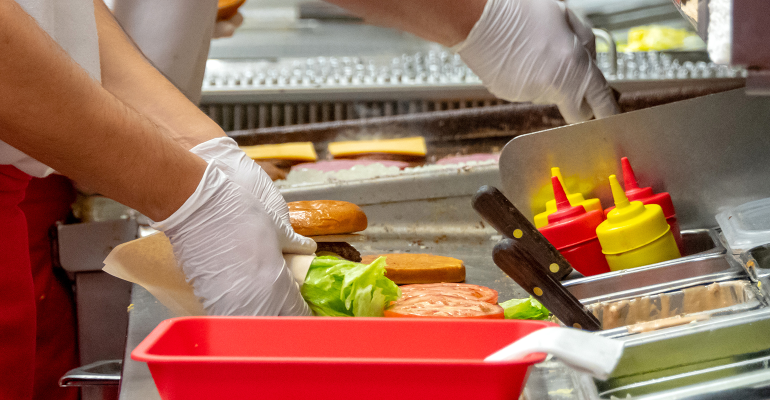The quick-service industry has seen tremendous change in the past few years, and we’re seeing a lot of innovation and transformation in the way these restaurants operate. But where are things heading for this business that is deeply embedded in local communities and economies — not just as a service provider to consumers, but as an employer and B2B customer?
Digging into the behind-the-scenes data collected by the dozens of systems that are used to operate a modern QSR, we can get a sense of how things have changed in recent years and which way the trends are pointing. While no one has a crystal ball, it’s easy to see how these trends have spurred some of the recent experiments in the industry, and where there is white space and opportunity for operators to fill gaps.
Data that comes straight from the restaurants themselves
Before weighing in, it’s worth taking a moment to talk about the data itself. Delaget, the company I lead, serves as a single dashboard that collects and presents data from the many systems used to operate restaurants, aggregates data from multiple locations, and puts the data into context to help leadership make better business decisions. Every year, we create a QSR Operational Index that identifies the biggest trends — and the insights from the 2022 edition are striking.
Important numbers and why they matter to QSR
There’s lots of great data that can give us insights about what’s happening in the world of QSR, but there are three areas where I think the data points the way to the future for restauranteurs: In the rise of the delivery channel, employee turnover, and loss prevention.
-
Big numbers for delivery: 1,343% growth (and rising) and 63% larger checks
The most significant trend is the continued growth and resilience of the third-party delivery channel for QSR — the DoorDashes and UberEats of the world. The delivery channel grew 1,343% from 2019 to 2022 — no surprise there given the boost seen in the pandemic years, but we now know it is continuing to grow. With a full year of data in which there were few widespread restrictions, we saw delivery grow by about 9.4% from 2021 to 2022 (from 9.5% to 10.39%).Delivery is good for business, too. Checks for delivery orders were 63% larger than for drive-thru in 2022, likely thanks to upselling and mark-ups. But delivery brings its share of challenges too – higher rates of order cancellations and loss of customer experience control on the part of restaurants, which creates new areas where QSRs need to adapt.
• Big numbers for labor: 283% turnover for smaller stores vs. 82% for larger stores
We’ve been inundated with stories about the tight labor market, rising wages and shocking turnover, but when you dig deeper into the data, it’s not quite that simple. There’s a big gap between what’s happening at stores with large numbers of employees and small numbers of employees. The top 10% in terms of headcount have a turnover rate of 82%, while the bottom ten percent have a rate almost 3.5 times higher.What’s happening here? I think it comes down to culture and the advantages larger stores enjoy in terms of building it. The largest stores are successful in recruiting and retaining good employees not because of wages — which are transparent and fairly consistent within geographic areas — but because they have invested in culture-building, things like employee appreciation and recognition, and features employees value such as earned wage access that lets them get their pay faster.
• Big numbers for loss: 16% increase in refunded transactions in 2022
Loss at QSRs can come in many forms, including internal theft (a major problem in the industry) and refunded transactions (which our data shows rose by 16% in 2022 over 2021.) The numbers are entwined but not completely locked — cancelling and refunding transactions is a way some thieves cover their tracks, but it is also tied to the rise of the delivery channel, where orders are more often changed, rejected or cancelled at the last moment, with restaurants often eating the losses.Digging deeper, we again see refunds, cancellations and losses unevenly distributed, with the bottom 10% of QSRs accounting for the lion’s share. Again, I think this can be a sign of culture issues — satisfied employees are less likely to steal from their employers — and also an investment in loss prevention tools by larger, more successful QSRs.
Looking to the future
What matters to owners and QRS brands is how they can use this data to improve their bottom line. I predict that we will see significant investment and innovation in certain areas because of the trends outlined here:
- New restaurant concepts tailored to delivery: Think small-footprint stores with dedicated lanes for delivery drivers, ghost kitchens producing food (perhaps for multiple brands) from one location exclusively for delivery, and other new ideas.
- Continued investment in culture and retention: Expect more programs and benefits that focus on making QSRs a fun place to work and that reward longevity, rather than sign-on bonuses. Look for brands to invest in their image publicly not just to attract customers, but workers.
- A focus on mitigating loss: New technologies will help mine data for suspicious activity and tie that activity to specific losses. Additionally, improving relationships with delivery companies and treating drivers like customers – including walking them through orders – can reduce unhappy delivery customers.
These are only some of the big trends and themes that have me excited as we look to the future. With better insights and measurement, the technology-driven QSR space is ripe for reinvention!
AUTHOR BIO
 Jason has more than 20 years of senior leadership experience in high-growth technology businesses. He co-founded his first company at the age of 24, a boutique technology consulting firm that was acquired three years later. More recently Jason led global sales and alliances at Shavlik Technologies until it was acquired by VMware, Inc. in 2011, where he served as Sr. Director, Sales. Jason joined JAMF Software in 2012, where he led global sales and marketing prior to joining Delaget in 2015 as CEO. Delaget, a 2015 Eureka! Award winner, is a SaaS analytics company, leveraging big data in the restaurant vertical to improve operations, minimize loss and deliver revenue and profitability growth.
Jason has more than 20 years of senior leadership experience in high-growth technology businesses. He co-founded his first company at the age of 24, a boutique technology consulting firm that was acquired three years later. More recently Jason led global sales and alliances at Shavlik Technologies until it was acquired by VMware, Inc. in 2011, where he served as Sr. Director, Sales. Jason joined JAMF Software in 2012, where he led global sales and marketing prior to joining Delaget in 2015 as CEO. Delaget, a 2015 Eureka! Award winner, is a SaaS analytics company, leveraging big data in the restaurant vertical to improve operations, minimize loss and deliver revenue and profitability growth.

